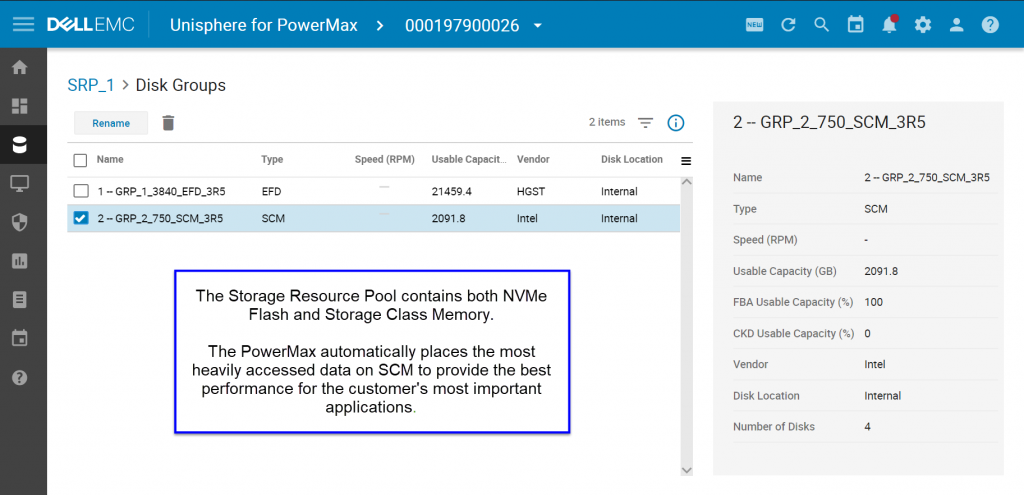I’m excited to share that this week at VMworld Europe, Dell EMC is previewing our latest PowerMax technology combined with another industry leader, VMware. This first of its kind technology preview continues to demonstrate Dell EMC’s commitment to storage innovation for virtual environments and the tight collaboration between Dell EMC and VMware. Our proven track record of providing next-generation technology helps our customers tackle their most demanding and mission-critical applications of today and tomorrow.
The entire engineering team and I are proud that our customers have made Dell EMC PowerMax the de facto standard for applications that require unmatched resiliency, uncompromising data services, and extreme levels of performance. Combined with the efficiencies and automation of PowerMax, IT organizations can modernize their infrastructure to drive massive workload consolidation, shrink hardware footprint, and reduce power consumption. All of which delivers more value to their business while lowering costs and reducing complexity.
Today we are excited to demonstrate how PowerMax can achieve game changing storage performance across virtualized environments. The demo showcases industry first technology and how Dell EMC will help users transition from today to tomorrow while protecting their current storage investments.
The technology of that tomorrow is NVMe and Storage Class Memory (SCM). SCM is cutting-edge storage media considered to be the next generation workhorse (at well below 100 microseconds latency!). It’s perfect for current and emerging performance hungry workloads. Use cases include supporting real-time and data-intensive analytics applications, as well as super-charging transactional OLTP and database workloads.
Today we are demonstrating the industry’s first storage array to fully exploit NVMe-connected SCM drives combined with end-to-end FC-NVMe networks. The result is a future proof combination that will completely shift the technology landscape. Storage decision makers are bullish about NVMe—79% of IT managers surveyed by ESG who were familiar with NVMe technology said they expect it to eventually replace traditional SAS- or SATA-connected solid-state flash storage.1
And here’s why the combination of NVMe networks with SCM drives are a game changer.
NVMe over Fabric does lots of cool things to take full advantage of Flash Arrays. It’s designed for extensive parallelism, concurrency and scalability to unlock the power of today’s multi-core CPUs and high-speed media. It provides end-to-end I/O optimizations, massive que depths, and lower latencies from the NVMe host bus adapters (HBAs) to PowerMax NVMe drives. It all adds to delivering more users to more application transactions with lower response times. And because we can leverage SAN networks, we can help protect your infrastructure investments.
Storage Class Memory represents the future of low latency persistent storage media. The performance of SCM is measured in tens of microseconds. It’s wicked fast and approaches the performance levels of DRAM, but at a lower cost and higher density compared to DRAM. The benefit to users is the ability to provide “in memory” like performance with consistent, predictable I/O latencies.
The ability to leverage the benefits of NVMe and SCM requires the right storage architecture. PowerMax is the world’s only Flash Array that includes an innovative, proven real-time machine learning engine that provides intelligent data placement. This intelligence optimizes NVMe and SCM performance without introducing management overhead. PowerMax allows users to transparently leverage both SCM technology for their highest priority, lowest latency workloads combined with cost efficient NVMe flash drives for their less active data sets. This differentiating capability is essential to helping IT organizations increase application performance, reduce storage costs, and minimize management complexity.
In this unprecedented demo with PowerMax that you’ll find at Dell EMC Booth D401, VM datastores reside on that ultra-low latency SCM drive technology and showcases how VMware recognizes PowerMax storage presented over traditional FC versus FC-NVMe, and how a VM can be moved between two datastores created on two different transport technologies, while on the same overall fabric. The ability to simultaneously run I/O over both FC and FC-NVMe on PowerMax is key to helping customers easily transition existing IT infrastructure to more powerful FC-NVMe networks.

Our close friends at VMware believe this demo is pretty special, too. “The Dell EMC PowerMax platform is ideally suited for large-scale, performance-driven VMware environments that will benefit most from the combination of storage class memory and FC-NVMe”, said Lee Caswell, Vice President Products, Storage and Availability Business Unit, VMware. “We are seeing an insatiable appetite for performance from high-end storage customers who value the deep integration VMware offers for Dell EMC PowerMax storage innovation.”
For everyone who likes to know the nuts and bolts, the PowerMax demo uses the following hardware and software:
- Dell EMC PowerMax 2000
- PowerMaxOS and Unisphere for PowerMax pre-GA builds
- 32Gb FC I/O modules running NVMe over Fabric pre-GA build
- 32Gb FC I/O modules running Fibre Channel pre-GA build
- 750GB NVMe Storage Class Memory Drives pre-GA build
- 8TB NVMe Flash Drives
- VMware vSphere ESXi and vCenter pre-GA builds*
* VMware does not promise any such functionality in its future release of vSphere
Both NVMe over Fabric and SCM online upgrades are planned to be available to PowerMax customers in 2019.
For more information, visit and watch this space: dellemc.com/powermax.
1 Source: ESG Survey Results, 2017 General Storage Trends, November 2017.